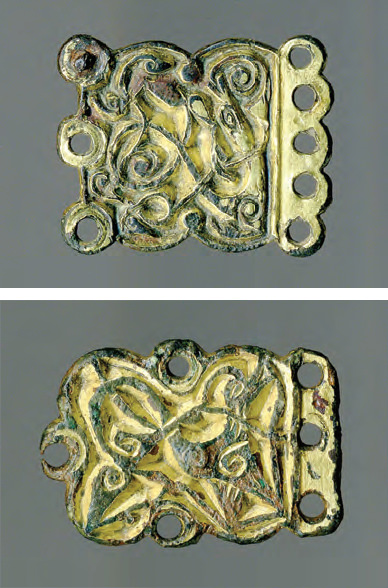„Die Beauftragte der Bundesregierung
für Kultur und Medien“
Aula regia
In the Aula regia, the master builders had used architectural features from various periods and cultures. In this manner, they built a magnificent stage for the ruler and an "international" setting for his widely travelled guests.
-

This equestrian statuette of a ruler, which was created around 870, symbolizes the Frankish, migrating form of government, called the itinerant regime: the king had no permanent residence, but constantly travelled, with his retinue, through the empire. (Paris, Musée du Louvre)
-

Register of stations and routes followed by Charlemagne during his reign. (To enlarge the view use the '+'-Symbol.)
-

Digital reconstruction of the interior of the Aula regia. A magnificently equipped setting for conferences of rulers, negotiations and judicial proceedings.
-

These small-sized remains of painted wall plaster were found during excavations in the Aula regia and provide evidence of the former colouring of the interior space.
-

Ground plan and reconstruction of the windows and the building plan. The two lateral entrances may have played an important role in the course of the solemn ceremonial.
-

Digital reconstruction of the external appearance of the Aula regia. The walls should not be imagined as masonry facades, but as plastered in white.
-

The basic shape of the Ingelheim Aula was influenced by models from antiquity, such as the Basilica of Constantine at Trier from the 4th century AD.
-

Mapping of the countries of origin of the Imperial Assembly convened by Louis the Pious in 826. The guests came to Ingelheim from all parts of the Old World.
-

Bronze reinforcement of the weapon belt (strap end) decorated with the so called Tassilo Chalice Style. Mythical creatures are intertwined with plant tendrils. Found near the Aula regia, 8th/early 9th century.
-

Finding places of the Tassilo Chalice Style. At the time, it was widely distributed, both on Anglo-Saxon and Danish soil as well as throughout the Frankish Empire. (To enlarge the view use the '+'-Symbol.)
-

Examples of sword-belt fittings. Above from Zellingen, Lkr. Main-Spessart, below from Karlstadt-Karlburg, Lkr. Main-Spessart (both Stadtgeschichtliches Museum, Karlburg).










